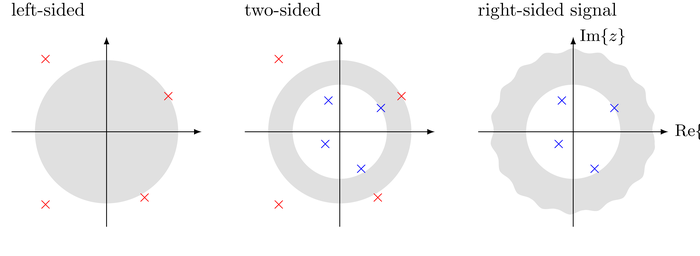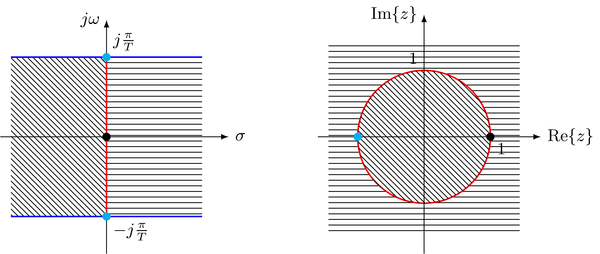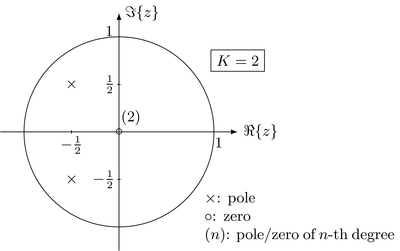The $z$-Transform¶
This Jupyter notebook is part of a collection of notebooks in the bachelors module Signals and Systems, Comunications Engineering, Universität Rostock. Please direct questions and suggestions to Sascha.Spors@uni-rostock.de.
Definition¶
The $z$-transform is a transform which represents a discrete signal $x[k]$ in the spectral domain. It bases on the complex exponential function $z^{-k}$ with $z \in \mathbb{C}$ as kernel.
Two-Sided $z$-Transform¶
The two-sided (or bilateral) $z$-transform is defined as
\begin{equation} X(z) = \sum_{k = -\infty}^{\infty} x[k] \, z^{-k} \end{equation}where $X(z) = \mathcal{Z} \{ x[k] \}$ denotes the $z$-transform of $x[k]$. A complex signal $x[k] \in \mathbb{C}$ with discrete index $k \in \mathbb{Z}$ is represented by its complex valued $z$-transform $X(z) \in \mathbb{C}$ with complex dependent variable $z \in \mathbb{C}$. The variable $z$ can be interpreted as complex frequency $z = e^{\Sigma + j \Omega}$ with $\Sigma, \Omega \in \mathbb{R}$.
Whether a $z$-transform $X(z) = \mathcal{Z} \{ x[k] \}$ exists depends on the complex frequency $z$ and the signal $x[k]$ itself. All values $z$ for which the $z$-transform converges form a region of convergence (ROC). The $z$-transforms of two different signals may differ only with respect to their ROCs. Consequently, the ROC needs to be explicitly given for a unique inversion of the $z$-transform.
One-Sided $z$-Transform¶
Causal signals play an important role in the theory of signals and systems. For a causal signal with $x[k] = 0$ for $k <0$, the relation $x[k] = x[k] \cdot \epsilon[k]$ holds. Introducing this into the definition of the two-sided $z$-transform results in
\begin{equation} X(z) = \sum_{k = -\infty}^{\infty} x[k] \cdot \epsilon[k] \, z^{-k} = \sum_{k = 0}^{\infty} x[k] \, z^{-k} \end{equation}This motivates the definition of the one-sided (or unilateral) $z$-transform
\begin{equation} X(z) = \sum_{k = 0}^{\infty} x[k] \, z^{-k} \end{equation}In the literature both the one- and two-sided $z$-transform are termed as $z$-transform. For causal signals both give the same result. The one-sided $z$-transform is also useful for the solution of initial value problems, for instance as defined by linear difference equations with constant coefficients where the initial values are e.g. defined for $k \leq 0$.
Signals of Finite Duration¶
The $z$-transform of a generic signal $x[k]$ of finite duration $x[k] = 0$ for $\{k : k < M_1 \wedge k \geq M_2\}$ with $M_1 < M_2$ reads
\begin{equation} X(z) = \sum_{k=M_1}^{M_2 - 1} x[k] \, z^{-k} = x[M_1] \, z^{-M_1} + x[M_1 + 1] \, z^{- (M_1 + 1)} + \dots + x[M_2 - 1] \, z^{- (M_2-1)} \end{equation}The transform of a generic finite-length signal is given as a polynomial in $z$. Depending on the particular limits $M_1$ and $M_2$, the polynomial may contain powers of $z$ and $z^{-1}$. For a causal finite-length signal, above result specializes to the case $M_1 = 0$ and $M_2 > 0$ as
\begin{equation} X(z) = x[0] + x[1] \, z^{-1} + \dots + x[M_2 - 1] \, z^{- (M_2-1)} \end{equation}The transform of a causal finite-length signal is given as a polynomial in $z^{-1}$. The ROC for this case is given as $z \in \mathbb{C} \setminus \{ 0 \}$. Similar considerations yield the $z$-transform and ROC of an anticausal signal. The ROCs for a generic finite-length signal can be summarized as
- $z \in \mathbb{C}$ for an anticausal signal ($M_1 < 0$, $M_2 \leq 0$)
- $z \in \mathbb{C}_\infty$ if $x[k] = 0$ for $k \neq 0$ ($M_1 = 0$, $M_2 = 1$)
- $z \in \mathbb{C} \setminus \{ 0 \}$ for a causal signal ($M_1 = 0$, $M_2 > 0$)
where $\mathbb{C}_\infty = \mathbb{C} \cup \{ \infty \}$ denotes the set of extended complex numbers.
Transformation of the Rectangular Signal¶
The rectangular signal $x[k] = \text{rect}_N[k]$ is a causal signal of finite duration. Using above result its $z$-transform can be derived straightforward as
\begin{equation} \mathcal{Z} \{ \text{rect}_N[k] \} = \sum_{k=0}^{N-1} z^{-k} = 1 + z^{-1} + \dots + z^{-N + 1} \end{equation}for $z \in \mathbb{C} \setminus \{ 0 \}$. Above sum can also be interpreted as finite geometrical series with common ratio $\frac{1}{z}$, resulting in an alternative form of the $z$-transform of the rectangular signal
\begin{equation} \mathcal{Z} \{ \text{rect}_N[k] \} = \begin{cases} \frac{1 - z^{-N}}{1 - z^{-1}} & \text{for } z \neq 1 \\ N & \text{for } z = 1 \end{cases} \end{equation}Transformation of the Dirac Impulse¶
The transform $\mathcal{Z} \{ \delta[k] \}$ of the Dirac impulse is derived by introducing $\delta[k]$ into the definition of the two-sided $z$-transform and exploiting the sifting property of the Dirac impulse
\begin{equation} \mathcal{Z} \{ \delta[k] \} = \sum_{k = -\infty}^{\infty} \delta[k] \, z^{-k} = 1 \end{equation}for $z \in \mathbb{C}$. The ROC covers the entire complex plane.
The transform of the Dirac impulse is equal to one. Hence, all complex frequencies $z$ are present with equal weight. Since the Dirac impulse is used to characterize linear time-invariant (LTI) systems by their impulse response $h[k] = \mathcal{H} \{ \delta[k] \}$, this constitutes an important property in the theory of discrete signals and systems, .
Example
The $z$-transform of the Dirac impulse is computed by direct evaluation of its definition. The Dirac impulse is represented by the Kronecker delta $\delta[k] = \delta_{k 0}$ in SymPy.
import sympy as sym
sym.init_printing()
%matplotlib inline
k = sym.symbols('k', integer=True)
z = sym.symbols('z', complex=True)
X = sym.summation(sym.KroneckerDelta(k, 0) * z**(-k), (k, -sym.oo, sym.oo))
X
Exercise
Derive the two-sided $z$-transform of a shifted Dirac impulse $\delta[t - \kappa]$ for $\kappa \in \mathbb{Z}$ by manual evaluation of its definition and by modification of above example. Provide the ROC for the three cases $\kappa<0$, $\kappa=0$ and $\kappa>0$.
Derive the one-sided $z$-transform of a shifted Dirac impulse $\delta[t - \kappa]$. Hint: Differentiate between the cases $\kappa < 0$ and $\kappa \geq 0$.
Transformation of the Causal Complex Exponential Signal¶
The transform $X(z) = \mathcal{Z} \{ x[k] \}$ of the causal complex exponential signal
\begin{equation} x[k] = \epsilon[k] \cdot z_0^k \end{equation}with complex frequency $z_0 \in \mathbb{C}$ is derived by evaluation of the definition of the one-sided $z$-transform
\begin{equation} X(z) = \sum_{k=0}^{\infty} z_0^k \cdot z^{-k} = \sum_{k=0}^{\infty} \left( \frac{z_0}{z} \right)^k = \frac{z}{z - z_0} \end{equation}The last equality has been derived by noting that the sum constitutes an infinite geometrical series with common ratio $\frac{z_0}{z}$ which converges for $\left| \frac{z_0}{z} \right| < 1$. The ROC is consequently given as
\begin{equation} |z| > |z_0| \end{equation}Combining above results, the transformation of the causal complex exponential signal reads
\begin{equation} \mathcal{Z} \{ \epsilon[k] \cdot z_0^k \} = \frac{z}{z - z_0} \qquad \text{for } |z| > |z_0| \end{equation}Example
The $z$-transform of the causal complex exponential signal $x[k] = z_0^k \cdot \epsilon[k]$ with $z_0 \in \mathbb{C}$ is computed by direct evaluation of its definition.
z0 = sym.symbols('z0')
X = sym.summation(z0**k * z**(-k), (k, 0, sym.oo))
X
Note that the sum is returned in case that it cannot be evaluated. It hence can be concluded that the series converges only for $|\frac{z_0}{z}| < 1$. This is in line with the analytic result derived above.
Convergence¶
The definition of the $z$-transform constitutes an infinite series. A sufficient but not necessary condition for the convergence of an infinite series is that its elements are absolutely summable. Applying this to the definition of the two-sided $z$-transform $X(z) = \mathcal{Z} \{ [k] \}$ of a given signal $x[k]$ yields
\begin{equation} \sum_{k = -\infty}^{\infty} | x[k] \cdot z^{- k} | = \sum_{k = -\infty}^{\infty} | x[k] | \cdot | z |^{- k} < \infty \end{equation}It can be concluded from this result that the ROC is determined solely by the magnitude $|z|$ of the complex frequency. It follows further that the ROC is given as a ring in the $z$-plane which may include $z=0$ and/or $z=\infty$. The phase $\Omega$ of the complex frequency $z$ has no effect in terms of convergence, as $z = e^{\Sigma} \cdot e^{j \Omega}$.
For a right-sided signal of infinite length with $x[k] = 0$ for $k < M$, the ROC is given in the form of $|z| > a$ with $a \in \mathbb{R}^+$. This can be concluded from the decay of the term $| z |^{- k}$ for $k \to \infty$, which ensures convergence for a given $a$. However this holds only for signals $x[k]$ with exponential growth. Please refer to the $z$-transform of the causal exponential signal derived above.
The same reasoning leads to the ROCs of a left-sided and two-sided signal. The resulting ROCs are illustrated in the following

The gray areas denote the values $z$ for which the $z$-transform converges. The borders $a$ of these areas (dashed lines) depend on the signal $x[k]$. In case that the $z$-transform $X(z)$ is given in terms of a rational function in $z$, the ROC has to be chosen such that it does not include zeros of the denominator polynomial. A more detailed discussion of the ROCs for the $z$-transform can be found in the literature, e.g. [Girod et al.].
Relation to the Laplace Transform of a Sampled Signal¶
The link between the Laplace transform of a sampled signal $x_\text{s}(t)$ and the $z$-transform of its discrete counterpart $x[k] = x(k T)$ is established in the following. Under the assumption of ideal sampling, the sampled signal reads
\begin{equation} x_\text{s}(t) = \sum_{k = -\infty}^{\infty} x(k T) \cdot \delta(t - k T) = \sum_{k = -\infty}^{\infty} x[k] \cdot \delta(t - k T) \end{equation}where $x(t)$ denotes the continuous signal and $T$ the sampling interval. Introducing the sampled signal into the definition of the Laplace transform yields the transform of the sampled signal
\begin{equation} X_\text{s}(s) = \int_{-\infty}^{\infty} \sum_{k = -\infty}^{\infty} x[k] \cdot \delta(t - k T) \, e^{- s t} \; dt = \sum_{k = -\infty}^{\infty} x[k] \, e^{-s k T} \end{equation}where the last equality has been derived by changing the order of summation/integration and exploiting the sifting property of the Dirac impulse. Comparison with the definition of the $z$-transform yields
\begin{equation} X_\text{s}(s) = X(z) \big\rvert_{z = e^{s T}} \end{equation}The spectrum of the sampled signal $X_\text{s}(s)$ is equal to the $z$-transform of the discrete Signal $X(z)$ for $z = e^{s T}$. The resulting mapping from the $s$-plane to the $z$-plane is illustrated by the shading and the colors in the following figure

The Laplace transform of a sampled signal is peridoic with respect to the frequency $\omega$. It sufficient to consider the strip $-\frac{\pi}{T} < \Im \{ s \} < \frac{\pi}{T}$ of the $s$-plane for the mapping. The left half-plane of the $s$-plane is mapped into the unit circle of the $z$-plane. The corresponding right half-plane is mapped to the outside of the unit circle. The imaginary axis of the $s$-plane is mapped onto the unit circle $|z|=1$. The frequency $s=0$ is mapped onto $z=1$ and the frequencies $s=\pm j \frac{\pi}{T}$ are mapped onto $z=-1$.
Representation¶
The $z$-transform $X(z) = \mathcal{Z} \{ x[k] \}$ depends on the complex frequency $z \in \mathbb{C}$ and is in general complex valued $X(z) \in \mathbb{C}$. It can be illustrated by plotting its magnitude $|X(z)|$ and phase $\varphi(z)$ or real $\Re \{ X(z) \}$ and imaginary $\Im \{ X(z) \}$ part in the complex $z$-plane. The resulting three-dimensional plots are often not very illustrative.
However, many $z$-transforms of interest in the theory of signals and systems are rational functions in $z$. The polynomials of the numerator and denominator can be represented by their complex roots and a constant factor. The roots of the numerator are termed as zeros while the roots of the denominator a termed as poles of $X(z)$. The polynomial and the zero/pole representation of a rational $z$-transform are equivalent
\begin{equation} X(z) = \frac{\sum_{m=0}^{M} \beta_m \, z^{-m}}{\sum_{n=0}^{N} \alpha_n \, z^{-n}} = K \cdot \frac{\prod_{\mu=0}^{Q} (z - z_{0 \mu})}{\prod_{\nu=0}^{P} (z - z_{\infty \nu})} \end{equation}where $M$ and $N$ denote the order of the numerator/denominator polynomial, $z_{0 \mu}$ and $z_{\infty \nu}$ the $\mu$-th zero/$\nu$-th pole of $X(z)$, and $Q = M-1$ and $P = N-1$ the total number of zeros and poles, respectively. For $M=N$ the factor $K = \frac{\beta_M}{\alpha_N}$. If
- $M > N$ at least one pole is located at $|z| = \infty$,
- $M < N$ at least one pole is located at $z = 0$.
It is common to illustrate the poles and zeros in a pole-zero plot. Here the locations of the complex poles and zeros, their degrees and the factor $K$ are plotted in the $z$-plane. It is common to include the unit circle $|z| = 1$ in the plot due to its relevance in the theory of discrete signals and systems. An example for a pole-zero plot is shown in the following

The locations of the poles and zeros provide insights into the composition of a signal. For instance, the $z$-transform of the complex exponential signal has a zero at $z=0$ and a pole at $z = z_0$. A signal which is composed from a superposition of complex exponential signals will have multiple poles whose positions are related to the complex frequencies of the signals it is composed of.
Exercise
- Derive $X(z)$ together with its ROC from above pole-zero plot under the assumption that it represents a right-sided signal $x[k]$.
Example
The $z$-transform of the causal complex exponential signal
\begin{equation} X(z) = \frac{z}{z - z_0} \qquad \text{for } |z| > |z_0| \end{equation}derived above is illustrated by plotting its magnitude $|X(z)|$ over the $z$-plane for $z_0 = 1 + j$
rez, imz = sym.symbols('rez imz', real=True)
X = z / (z - z0)
X1 = X.subs({z: rez+sym.I*imz, z0: 1+sym.I})
sym.plotting.plot3d(abs(X1), (rez, -2, 2), (imz, -2, 2),
xlabel=r'$\Re\{z\}$', ylabel=r'$\Im\{z\}$', title=r'$|X(z)|$');
Alternatively, the $z$-transform $X(z)$ is illustrated by its pole-zero plot. First the poles
poles = sym.roots(sym.denom(X), z)
poles
and zeros are computed
zeros = sym.roots(sym.numer(X), z)
zeros
Above dictionaries are composed from the poles and zeros, and their degrees.
In order to illustrate the location of poles and zeros in the $z$-plane, the pole-zero plot is shown for $z_0 = 1 + j$
from pole_zero_plot import pole_zero_plot
X2 = X.subs(z0, 1+sym.I)
pole_zero_plot(sym.roots(sym.denom(X2), z), sym.roots(sym.numer(X2), z))
Copyright
The notebooks are provided as Open Educational Resource. Feel free to use the notebooks for your own educational purposes. The text is licensed under Creative Commons Attribution 4.0, the code of the IPython examples under the MIT license. Please attribute the work as follows: Lecture Notes on Signals and Systems by Sascha Spors.